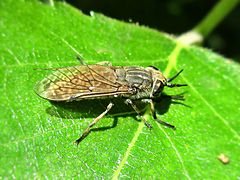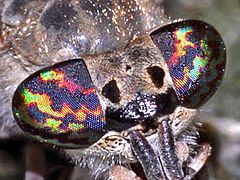
Horse-flies or horseflies are true flies in the family Tabanidae in the insect order Diptera. They are often large and agile in flight. Only female horseflies bite animals, and humans, to obtain blood. They prefer to fly in sunlight, avoiding dark and shady areas, and are inactive at night. They are found all over the world except for some islands and the polar regions. Both horse-flies and botflies (Oestridae) are sometimes referred to as gadflies.
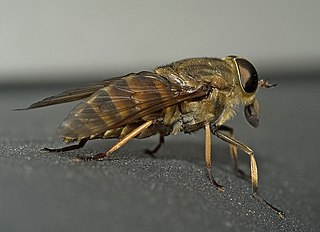
The Brachyceran infraorder Tabanomorpha is a small group that consists primarily of two large families, the Tabanidae and Rhagionidae, and an assortment of very small affiliated families, most of which have been included within the Rhagionidae.

Tabanus bovinus, sometimes called the pale giant horse-fly, is a species of biting horse-fly. As the scientific name suggests, it prefers bovine animals as the source of blood, although it may bite other kind of mammals as well. The insect is relatively large for a horse-fly, adults usually being 25–30 mm long. Like most other horseflies, its compound eyes are very colorful with stripe-like patterns. Its body and wings are mostly colored brownish gray. It is quite fast and an able flier, being capable of evading most attempts to swat it with ease. It bites humans infrequently, because of its preference of bovine animals. This loud-buzzing horse-fly can be a nuisance, as it circles around its target and occasionally lands to deliver a bite. However, to humans it is considerably less harmful than deer flies (Chrysops), which bite much more vigorously.

Tabanus is a genus of biting horseflies of the family Tabanidae. Females have scissor-like mouthparts that aim to cut the skin. The horsefly can then lap up the blood. Horseflies of this genus are known to be potential vectors of anthrax, worms and trypanosomes. Some species, such as Tabanus bovinus, prefer bovine animals and are less harmful to humans. The genus contains hundreds of species and many species groups.

Tabanus bromius, sometimes called the band-eyed brown horsefly, is a species of biting horseflies.

Tabanus glaucopis, also known as the downland horsefly, is a species of biting horse-fly.

Tabanus maculicornis also known as the narrow-winged horsefly is a species of biting horse-fly.

Tabanus sudeticus, also known as the dark giant horsefly, is a species of biting horse-fly. It is the heaviest fly in Europe.

Haematopota is a genus of flies in the horse-fly family, Tabanidae. Among the horse-flies, they are most commonly known as clegs. Many species have colorful, sinuously patterned eyes in life, a character that fades after death. The wings are typically patterned with spots of grey. The genus is named from the Ancient Greek for blood-drinker: αἷμα, haîma, blood; πότης, pótës, drinker. Some species are known to be vectors of livestock diseases.

Athericidae is a small family of flies known as water snipe flies or ibis flies. They used to be placed in the family Rhagionidae, but were removed by Stuckenberg in 1973. They are now known to be more closely related to Tabanidae. Species of Athericidae are found worldwide.

Philipomyia aprica is a species of horse fly of the family Tabanidae, subfamily Tabaninae.
Diptera is an order of winged insects commonly known as flies. Diptera, which are one of the most successful groups of organisms on Earth, are very diverse biologically. None are truly marine but they occupy virtually every terrestrial niche. Many have co-evolved in association with plants and animals. The Diptera are a very significant group in the decomposition and degeneration of plant and animal matter, are instrumental in the breakdown and release of nutrients back into the soil, and whose larvae supplement the diet of higher agrarian organisms. They are also an important component in food chains.

Chrysops caecutiens, common name splayed deer fly, is a species of horse fly belonging to the family Tabanidae. It is also known by the colloquial name Scotch Cleg.

Hybomitra aterrima is a species of horse flies in the family Tabanidae.
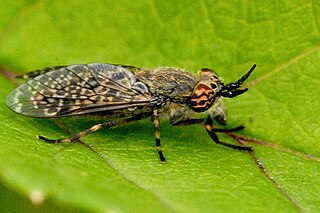
Haematopota crassicornis, the black-horned cleg is a species in the horse-fly family, Tabanidae.
Haematopota bigoti is a species of Horse-fly.
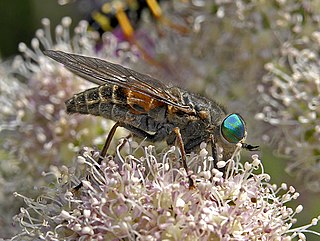
Hybomitra montana, the slender-horned horsefly, is a species of horse flies in the family Tabanidae.

Many species of flies of the two-winged type, Order Diptera, such as mosquitoes, horse-flies, blow-flies and warble-flies, cause direct parasitic disease to domestic animals, and transmit organisms that cause diseases. These infestations and infections cause distress to companion animals, and in livestock industry the financial costs of these diseases are high. These problems occur wherever domestic animals are reared. This article provides an overview of parasitic flies from a veterinary perspective, with emphasis on the disease-causing relationships between these flies and their host animals. The article is organized following the taxonomic hierarchy of these flies in the phylum Arthropoda, order Insecta. Families and genera of dipteran flies are emphasized rather than many individual species. Disease caused by the feeding activity of the flies is described here under parasitic disease. Disease caused by small pathogenic organisms that pass from the flies to domestic animals is described here under transmitted organisms; prominent examples are provided from the many species.

Hybomitra caucasica is a species of horse flies in the family Tabanidae.


